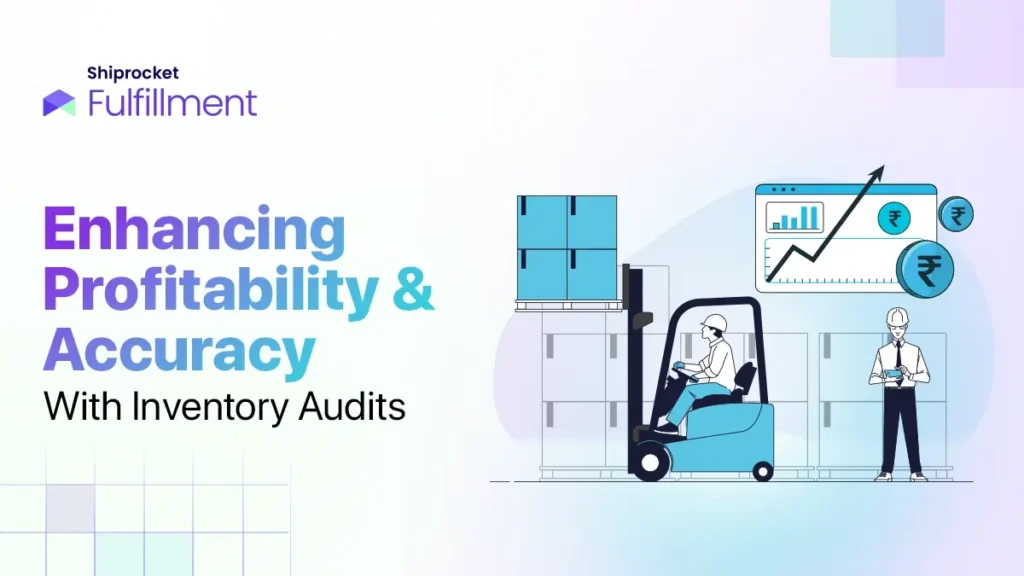- Inventory Audit: An In-depth Detail
- Commonly Used Inventory Audit Analyses
- Significance of Inventory Auditing for eCommerce Enterprises
- Difficulties in Carrying Out an Inventory Audit
- Tackle the Challenges in Inventory Auditing: Tips
- Shiprocket: Track and Update Your Inventory Using Inventory Management
- Conclusion
Audits are a way to check if every piece of your stock falls in place and is well-managed. Efficient inventory management is the backbone of any successful business. Conducting regular inventory audits provides insight into the financial status of a business. Performing audits demands a significant investment of time and manual effort but is quintessential for firms to maintain control and accuracy over their stock levels.

The year’s final quarter is usually a high-pressure period for retailers, as the holiday season’s buildup significantly influences their annual performance. Inventory auditing is a common practice at the end of the year for eCommerce enterprises. Companies perform these audits for taxation purposes or as a routine check to confirm the available units.
There are two ways to go about these inventory audits. Either firms choose to execute the audit internally or entrust the process to a third party. Several companies engage in a comprehensive physical inventory count with the help of an auditor. This article delves into the intricacies of inventory auditing to help businesses streamline their processes, mitigate risks, and maximise their growth potential.
Inventory Audit: An In-depth Detail
Inventory audit is where a company evaluates the actual inventory quantities against its financial records and intends to verify precise inventory accounting. It helps detect potential issues related to inventory storage and accounting practices employed by the company. For some firms, inventory auditing can be a straightforward verification by physically counting stock levels and cross-checking them with financial records. For others, it could be a more complex scenario where an external auditor or third party thoroughly analyses all inventory procedures.
Commonly Used Inventory Audit Analyses
Two primary methods for counting inventory are physical and Cycle Counts. Physical counts are extensive since they are more labour-intensive and disruptive for business operations. In contrast, cycle counts adopt a more streamlined approach and are generally less intrusive. It is a focused inventory sampling technique, where a firm regularly chooses specific items for measuring to compare the results to the inventory management system and unveil any variances. This method is very effective for businesses with high inventory volumes. It allows them to minimise the need for total physical counts to once a year.
Physical Inventory Counts:
Companies conduct physical inventory counts to ensure the financial records align with physical stock. In this method, you count every unit of inventory meticulously. It helps manage inventory shrinkage, reduce stockouts, and improve business demand forecasting.
This process is traditionally manual, but the use of barcodes and barcode scanners for recording inventory, in recent times, has significantly expedited the process. Moreover, incorporating inventory management software has proven invaluable in maintaining accurate inventory records during these physical counts.
Cutoff Analysis:
The cut-off analysis method pauses daily operations, like incoming and outgoing inventory, during a physical count to avoid potential errors. It’s advisable to inform your
customers to prepare for delays. Customers and stakeholders should know about the ongoing inventory audit beforehand.
ABC Analysis:
Adopting the ABC analysis technique means grouping items into three categories according to their value. For instance, the high-value items may fall in the A category, medium-value items in the B category and low-value items in C. Items are cast in groups to bring the auditor’s focus on prioritising high-value items.
Freight Cost Analysis:
Freight cost analysis examines the cost incurred in shipping and transporting products to various locations. This process includes analysing freight costs and recording the period between shipping and receiving dates. It helps account for any products being lost or damaged in transit.
When inventory is in transit to and from destinations, auditors can analyse the transfer documentation and add that inventory to the count. Freight cost analysis aids the business in making informed decisions regarding shipments, giving a deeper insight into freight logistics.
Analytical Procedures:
Analytical procedures help understand trends by analysing the historical data relating to financial metrics like inventory turnover ratio, gross margins, inventory costs, and days inventory was on hand. It propels firms to make better decisions while forecasting demand or procuring lists.
Overhead Analysis:
It’s inevitable for businesses to supervise any additional costs in inventory audits besides the direct costs like material and labour. Overhead analysis is a way to analyse overhead costs, such as rent, electricity, utilities and miscellaneous fees, that affect inventory management. Such analysis helps businesses scale their budget and determine which expenses impact their profit margins.
Finished Goods Cost Analysis:
A finished goods cost analysis is a perfect inventory audit measure for producers and manufacturers. In this analysis, the auditor calculates the inventory value of finished goods for the current accounting period to control inventory efficiently and verify the financial statements. Businesses that adopt finished good analysis can reduce inventory storage costs and make more informed decisions when determining product pricing or ordering raw materials.
Matching Invoices:
While conducting an inventory audit, auditors may need to verify the accuracy of the amount charged for a product sold to a customer. The matching of invoices against the shipping log reveals any discrepancies. They tally the invoices with the number of items and the cost of inventory shipped from the warehouse. This cross-checking helps businesses improve the accuracy of their orders and avoid any shipping mistakes and redundant charges.
Reconciliation of Items:
To reconcile the inventory, an auditor tallies the physical inventory count with the inventory records. Firms can conduct frequent and consistent inventory reconciliations to reduce stock discrepancies and identify the root cause of the alterations. It’s essential to match the physical inventory with inventory records regularly, look into purchase invoices, shipment details, and documentation, and rectify the discrepancies.
Significance of Inventory Auditing for eCommerce Enterprises
As we know, financial documentation is internal work; it poses a considerable risk of manipulation by internal parties. There is a possibility of insiders making unintentional errors or deliberately being mischievous while preparing financial records. Inventory audits safeguard companies from potential mistakes and fraudulent behaviour. Furthermore, audits ensure that entities adhere to pertinent accounting standards.
eCommerce enterprises comprise different inventories than physical stores. Orders for eCommerce stores can pop from anywhere worldwide, at any time. It makes the handling of stocks more challenging and pushes the need to use state-of-the-art technology and productive approaches for inventory control. There are several reasons as to why these enterprises must do regular inventory audits.
Firstly, an inventory audit is a perfect tool to calculate profits by ensuring accuracy in inventory accounting, tracking changes in inventory value over time, and mitigating the risk of shrinkage or impact of slow-moving products.
Secondly, accurate stock tracking through inventory audits allows the drafting of more precise budgets. It helps businesses plan better for future purchases with a more intricate view of overall inventory.
Moreover, inventory audits can spot inefficiencies in business operations, such as slow-selling products or operational errors. This information comes in handy to businesses in discontinuing unsuccessful products, bolstering successful ones, and optimising various aspects of their supply chain.
Lastly, eCommerce enterprises can substantially reduce overall costs and achieve financial efficiency through inventory audits. These audits help identify and limit holding costs related to inventory.
Difficulties in Carrying Out an Inventory Audit
While the benefits of periodic inventory audits are evident in increasing visibility across the supply chain, carrying out these comes with challenges. These audits pose several difficulties that businesses must grapple with.
Prolonged process:
Firstly, inventory audits are inherently time-consuming and complex, Whether it’s about dealing with a vast inventory or a single SKU with a substantial quantity. Manually checking actual inventory against electronically recorded levels or inventory sheets may take several days. Due to the intricacy of this task, it becomes necessary to opt for an electronic approach to inventory reporting to save time and access updated information across various locations.
Challenges in Scaling:
Secondly, scalability introduces a new layer of complexity. As eCommerce businesses grow, they must adopt more strategic inventory solutions. Although full physical inventory audits are essential, spot-checking is a more manageable approach to maintaining control between extensive audits. This process involves selecting specific products, counting the on-hand units, and comparing them to the system’s recorded quantities.
Operational Halts:
The most challenging is the operational disruption due to inventory audits. Even momentarily pausing operations for an audit can significantly halt various functions, including order fulfillment and timely shipment to customers. We’re in a time when meeting customer expectations, especially regarding prompt delivery, is critical. Operational halts can impact the customer experience and brand perception.
Tackle the Challenges in Inventory Auditing: Tips
The difficulties in inventory auditing underscore the need for businesses to adopt strategic approaches, leverage technology, and carefully plan audit schedules to mitigate disruptions and optimise the inventory auditing process. This process encompasses precise planning, execution, and analysis.
Here are some tips to navigate the audit stages successfully:
Evaluate Items for Audit: The first stage involves evaluating items for audit based on their risk. Prioritise products with higher risk, utilising SKUs and barcodes for effective sorting.
Schedule Audits Strategically: Next, consider low-activity periods and the inclusion of high-volume items to schedule inventory audits strategically and minimise disruption to daily business operations.
Collect Necessary Documents: Gather the documents required for the audit to ensure the process is smooth and secure.
Conduct Thorough Audits: When conducting thorough audits, choose the appropriate type of process based on your business’s nature. Delegate the responsibility of implementing the audit to an unbiased internal auditor.
Record Audit Findings: Document the findings of the inventory audit systematically to identify operational gaps and areas for improvement. Maintain a record of results from year to year or cycle to cycle for continuous monitoring and assessment.
Reporting and Monitoring: In the reporting and monitoring phase, create a comprehensive report summarising the essential findings and suggestions from the inventory audit. Additionally, you can use the previous reports as benchmarks in future audits to track improvements over time.
Shiprocket: Track and Update Your Inventory Using Inventory Management
As you work profusely to grow your business, Shiprocket’s inventory management system can help you manage your inventory efficiently by tracking your existing inventory systematically.
You can achieve complete control over centralising your inventory across channels with a single platform.
Essential Features of Shiprocket’s Inventory Management System are:
- Sync your inventory and control omnichannel sales
- Get inventory tracking and updates with ease
- Auto-synching inventory for the best shopping experience
- Manage your inventory on-the-go
- Get inventory management reports.
Take a look at the additional features of Inventory Management with Shiprocket.
Conclusion
eCommerce enterprises face many hurdles in inventory management today as they navigate the complexities of modern commerce. Conducting productive and regular inventory audits has become integral to running an effective business. Accurate inventory accounting, timely audits, and technology integration can ensure compliance with accounting standards. They also aid companies in making informed decisions, preventing stockouts, optimising budgets, and elevating overall customer satisfaction. However, the multifaceted nature of inventory audits requires a strategic and systematic approach. By diligently implementing the insights from these best practices, businesses can streamline their auditing processes and establish a solid foundation for consistent growth and success in eCommerce.
The frequency of inventory audits depends on various factors, including the nature of the business, the industry, and specific inventory management needs. However, it’s best to conduct regular audits annually or more frequently.
While some businesses prefer conducting internal audits, involving a third-party auditor can provide an unbiased perspective and ensure a more thorough examination of inventory management practices.
Employee training is crucial as it prepares the staff for the audit by helping them understand audit procedures, use technology effectively, and learn to maintain accurate inventory records.




